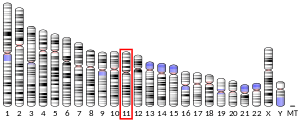RARRES3
Retinoic acid receptor responder protein 3 is a protein that in humans is encoded by the RARRES3 gene.[3][4]
Retinoids exert biologic effects such as potent growth inhibitory and cell differentiation activities and are used in the treatment of hyperproliferative dermatological diseases. These effects are mediated by specific nuclear receptor proteins that are members of the steroid and thyroid hormone receptor superfamily of transcriptional regulators. RARRES1, RARRES2, and RARRES3 are genes whose expression is upregulated by the synthetic retinoid tazarotene. RARRES3 is thought act as a tumor suppressor or growth regulator.[4]
Interactions
RARRES3 has been shown to interact with RNF135.[5]
gollark: No.
gollark: I guess I can edit it.
gollark: It worked on all my testing systems.
gollark: Why not? Did you try the latest version?
gollark: Also incdec when it works.
References
- GRCh38: Ensembl release 89: ENSG00000133321 - Ensembl, May 2017
- "Human PubMed Reference:". National Center for Biotechnology Information, U.S. National Library of Medicine.
- Duvic M, Nagpal S, Asano AT, Chandraratna RA (Sep 1997). "Molecular mechanisms of tazarotene action in psoriasis". J Am Acad Dermatol. 37 (2 Pt 3): S18–24. doi:10.1016/s0190-9622(97)80396-9. PMID 9270552.
- "Entrez Gene: RARRES3 retinoic acid receptor responder (tazarotene induced) 3".
- Oshiumi, Hiroyuki; Matsumoto Misako; Hatakeyama Shigetsugu; Seya Tsukasa (Jan 2009). "Riplet/RNF135, a RING finger protein, ubiquitinates RIG-I to promote interferon-beta induction during the early phase of viral infection". J. Biol. Chem. United States. 284 (2): 807–17. doi:10.1074/jbc.M804259200. ISSN 0021-9258. PMID 19017631.
Further reading
- Nagpal S, Patel S, Jacobe H, et al. (1997). "Tazarotene-induced gene 2 (TIG2), a novel retinoid-responsive gene in skin". J. Invest. Dermatol. 109 (1): 91–5. doi:10.1111/1523-1747.ep12276660. PMID 9204961.
- DiSepio D, Ghosn C, Eckert RL, et al. (1999). "Identification and characterization of a retinoid-induced class II tumor suppressor/growth regulatory gene". Proc. Natl. Acad. Sci. U.S.A. 95 (25): 14811–5. Bibcode:1998PNAS...9514811D. doi:10.1073/pnas.95.25.14811. PMC 24531. PMID 9843971.
- Huang SL, Shyu RY, Yeh MY, Jiang SY (2000). "Cloning and characterization of a novel retinoid-inducible gene 1(RIG1) deriving from human gastric cancer cells". Mol. Cell. Endocrinol. 159 (1–2): 15–24. doi:10.1016/S0303-7207(99)00207-5. PMID 10687848.
- Duvic M, Helekar B, Schulz C, et al. (2000). "Expression of a retinoid-inducible tumor suppressor, Tazarotene-inducible gene-3, is decreased in psoriasis and skin cancer". Clin. Cancer Res. 6 (8): 3249–59. PMID 10955811.
- Deucher A, Nagpal S, Chandraratna RA, et al. (2001). "The carboxy-terminal hydrophobic domain of TIG3, a class II tumor suppressor protein, is required for appropriate cellular localization and optimal biological activity". Int. J. Oncol. 17 (6): 1195–203. doi:10.3892/ijo.17.6.1195. PMID 11078805.
- Strausberg RL, Feingold EA, Grouse LH, et al. (2003). "Generation and initial analysis of more than 15,000 full-length human and mouse cDNA sequences". Proc. Natl. Acad. Sci. U.S.A. 99 (26): 16899–903. Bibcode:2002PNAS...9916899M. doi:10.1073/pnas.242603899. PMC 139241. PMID 12477932.
- Higuchi E, Chandraratna RA, Hong WK, Lotan R (2003). "Induction of TIG3, a putative class II tumor suppressor gene, by retinoic acid in head and neck and lung carcinoma cells and its association with suppression of the transformed phenotype". Oncogene. 22 (30): 4627–35. doi:10.1038/sj.onc.1206235. PMID 12879006.
- Sturniolo MT, Dashti SR, Deucher A, et al. (2004). "A novel tumor suppressor protein promotes keratinocyte terminal differentiation via activation of type I transglutaminase". J. Biol. Chem. 278 (48): 48066–73. doi:10.1074/jbc.M307215200. PMID 12928434.
- Yoneyama M, Kikuchi M, Natsukawa T, et al. (2004). "The RNA helicase RIG-I has an essential function in double-stranded RNA-induced innate antiviral responses". Nat. Immunol. 5 (7): 730–7. doi:10.1038/ni1087. PMID 15208624.
- Gerhard DS, Wagner L, Feingold EA, et al. (2004). "The status, quality, and expansion of the NIH full-length cDNA project: the Mammalian Gene Collection (MGC)". Genome Res. 14 (10B): 2121–7. doi:10.1101/gr.2596504. PMC 528928. PMID 15489334.
- Jiang SY, Chou JM, Leu FJ, et al. (2005). "Decreased expression of type II tumor suppressor gene RARRES3 in tissues of hepatocellular carcinoma and cholangiocarcinoma". World J. Gastroenterol. 11 (7): 948–53. doi:10.3748/wjg.v11.i7.948. PMC 4250783. PMID 15742394.
- Sturniolo MT, Chandraratna RA, Eckert RL (2005). "A novel transglutaminase activator forms a complex with type 1 transglutaminase". Oncogene. 24 (18): 2963–72. doi:10.1038/sj.onc.1208392. PMID 15846304.
- Jiang SY, Wu MS, Chen LM, et al. (2005). "Identification and characterization of the retinoic acid response elements in the human RIG1 gene promoter". Biochem. Biophys. Res. Commun. 331 (2): 630–9. doi:10.1016/j.bbrc.2005.03.214. PMID 15850806.
- Lotz K, Kellner T, Heitmann M, et al. (2005). "Suppression of the TIG3 tumor suppressor gene in human ovarian carcinomas is mediated via mitogen-activated kinase-dependent and -independent mechanisms". Int. J. Cancer. 116 (6): 894–902. doi:10.1002/ijc.21127. PMID 15856468.
- Kimura K, Wakamatsu A, Suzuki Y, et al. (2006). "Diversification of transcriptional modulation: large-scale identification and characterization of putative alternative promoters of human genes". Genome Res. 16 (1): 55–65. doi:10.1101/gr.4039406. PMC 1356129. PMID 16344560.
- Guo Z, Chen LM, Zeng H, et al. (2007). "NS1 protein of influenza A virus inhibits the function of intracytoplasmic pathogen sensor, RIG-I". Am. J. Respir. Cell Mol. Biol. 36 (3): 263–9. doi:10.1165/rcmb.2006-0283RC. PMID 17053203.
- Chen Z, Benureau Y, Rijnbrand R, et al. (2007). "GB virus B disrupts RIG-I signaling by NS3/4A-mediated cleavage of the adaptor protein MAVS". J. Virol. 81 (2): 964–76. doi:10.1128/JVI.02076-06. PMC 1797450. PMID 17093192.
- Tsai FM, Shyu RY, Jiang SY (2007). "RIG1 suppresses Ras activation and induces cellular apoptosis at the Golgi apparatus". Cell. Signal. 19 (5): 989–99. doi:10.1016/j.cellsig.2006.11.005. PMID 17196792.
This article is issued from Wikipedia. The text is licensed under Creative Commons - Attribution - Sharealike. Additional terms may apply for the media files.


